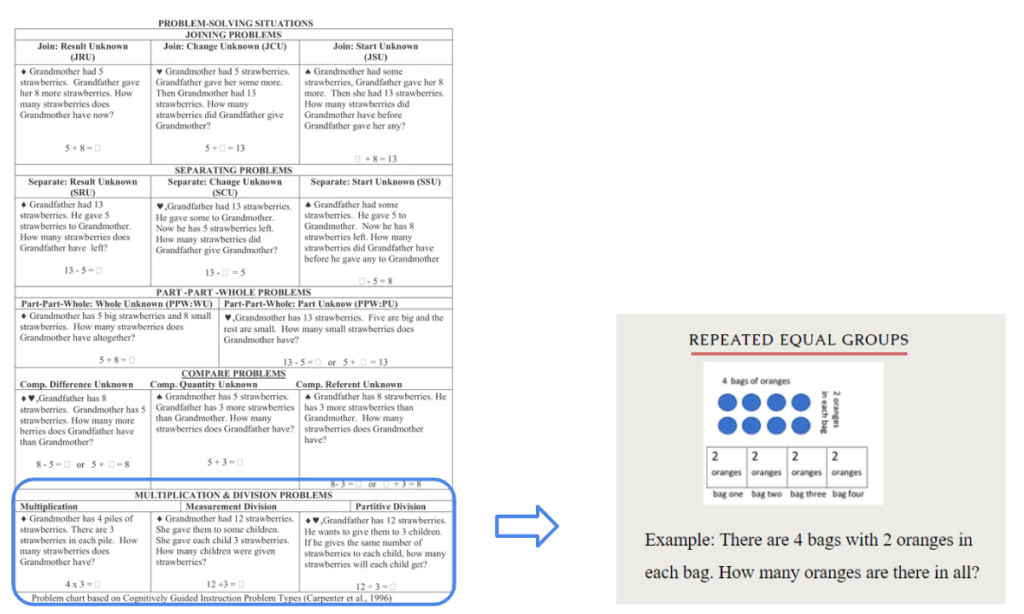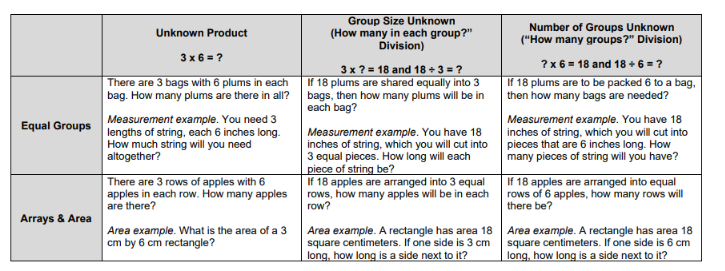January 17, 2024
In the last two blogs, I gave examples of how to teach the Compare and Parts Equal Total structures to help students solve word problems. It’s no secret that students struggle with understanding what problems are asking. And teachers wonder the best way to explain them, particularly when it comes to multiplication and division.
A common question asked by teachers is “How do you get kids to understand multiplication and division word problems?” Today I’ll help answer that as we go into the third structure, Repeated Equal Groups (REG).
We’ll explore:
- sample 3rd & 4th grade story problems
- How they relate to CGI
- How the REG structure relates to the standards
- The gaps filled by Structures of Equality (SoE)
Setting the stage for success
Before you use any structure to visually represent a number story, it’s important to build the context for the problems through questioning and discussion.
Here are a few of my go-to story element questions:
- What do you notice?
- What’s happening in the story?
- What’s the setting?
- Who are the characters?
- What’s the action? (What’s the verb?)
- What’s the math main idea?
- What’s the thing we’re counting?
- Close your eyes and visualize the story. Have you ever had (item)?
- What’s a (item)?
Once students have an understanding of the context, you’re ready to think about how to represent it with a structure.
What does it look like to model a problem with a Repeated Equal Groups (REG) structure?
This SoE is helpful if a math story describes putting equal groups together (compose) or taking equal groups apart (decompose). We often think of these are multiplication and division word problems. There are some number stories that could be represented with this model or a Parts Equal Total structure.
In a previous blog, I walked you through what an example problem could look like in the classroom. Today, let’s start with a story that describes a multiplicative relationship (sometimes referred to as a multiplication problem). First, I’ll represent it as PET then show you how to model it with a REG structure.
The second video is of a math story that describes decomposing a total into equal parts. I encourage you to solve it on your own first, then watch the video. This will help you anticipate misconceptions that might occur while students are first working with REG. (I recently interviewed a teacher who’s implementing SoE for the first time. This was one of her tips, to work out the problems before doing them with students.)
Max the Monkey loves bananas. His trainer, Molly, has 24 bananas. If she gives Max 4 bananas each day, how many days will the bananas last?
How the REG structure relates to Cognitively Guided Instruction (CGI)
There are 3 CGI problem types that can be represented with a single structure,
REG. This allows students to focus on the relationships and create a visual representation before they worry about symbolic representations

How does the REG structure support understanding of 3rd-grade word problems?

In order for students to understand what is happening in a number story, they have to understand what the values within the problem mean. Since all SoE require students to use labels, they must understand the context in order to accurately represent it with a REG structure.
As students move from additive to multiplicative thinking, the units and labels become harder to grapple with. Instead of composing or decomposing like units, each value represents something different (groups, number in each group, or the total).
The REG structure also makes the connection between arrays and the representation explicit, scaffolding the learning for students.
All 6 situations shown below can be represented with this one structure.

How does REG structure support understanding of 4th-grade word problems?

As students progress into 4th grade, they are confronted with number stories “in which one quantity is multiplied by a specified number to get another quantity (e.g., “a is n times as much as b.”)… Students should be able to identify and verbalize which quantity is being multiplied and which number tells how many times.” (NC DPI Unpacking Grade 4, June 2022)
This relationship can be represented using a bar model. However, even when represented correctly, it’s impossible to tell if the students understand what the model represents if values, labels and equality are not included in the representation. With a REG, they’re required to interpret the value.
Conclusion
The REG structure sets students up to successfully comprehend and solve multiplication and division word problems. If used consistently, there is no need to revert to tips or tricks, such as step-by-step procedures or keywords. Students are able to represent and interpret these word problems accurately. Once a math story is mapped out using a SoE, their working memory is freed up to work on computation.
Although this structure is a bit complicated at first, it’s a reading comprehension tool that eventually allows all students to access story problems with ease.
Do you want more information on SoE? Make sure you’re on my email list so you get exclusive access to freebies and actionable tips.
Resources:
NC Department of Public Education. (2022, June). 3rd Grade Mathematics Unpacked Content.https://www.dpi.nc.gov/nc-3rd-grade-math-unpacking-rev-june-2022/open
NC Department of Public Education. (2022, June). 4th Grade Mathematics Unpacked Content https://www.dpi.nc.gov/nc-4th-grade-math-unpacking-rev-june-2022/open